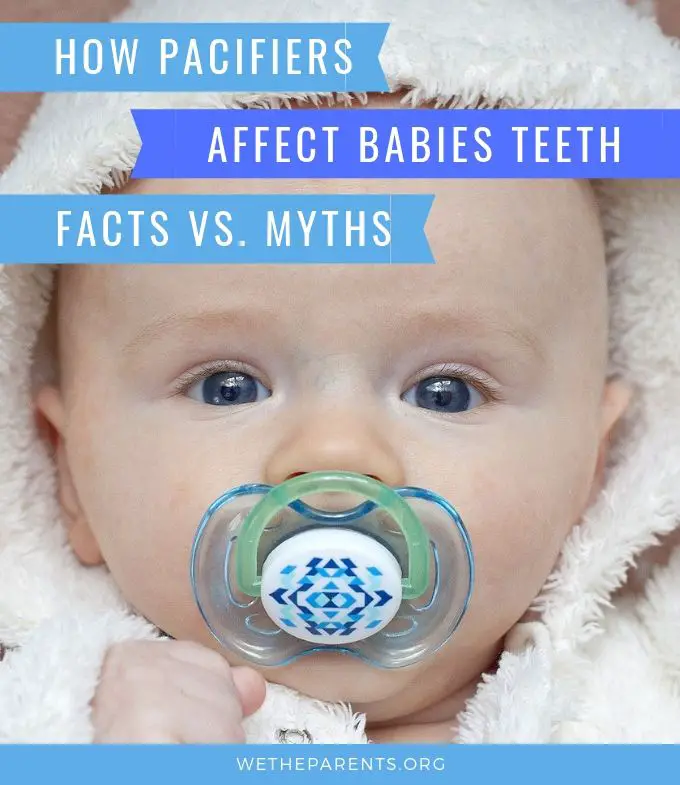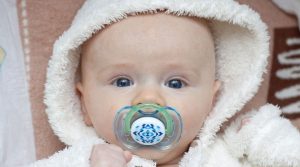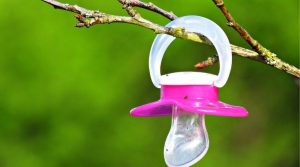Parents know that pacifiers can prevent breakdowns — yours, not the baby’s. Infants can lose a lot of their charm after a few hours of incessant crying.
Pacifiers are chewed and sucked on by babies. They can frequently help an infant to suck for comfort and fall asleep.
Also, a bad teething day is a good time for some serious chewing on the pacifier. Eventually, it becomes the primary means by which babies soothe themselves in stressful situations.
The other option, of course, is thumb or finger sucking. Many babies will move to this if not offered a pacifier.1Finger Sucking in Children
hopkinsallchildrens.org/ACH-News/General-News/Finger-Sucking-in-Children
- Babies use a strong sucking or chewing motion with the pacifier when in pain from colic or teething. Studies have shown that this action, called non-nutritive sucking, calms them and helps them cope with the discomfort.2Riddell, R. R. P., Racine, N. M., Gennis, H. G., Turcotte, K., Uman, L. S., Horton, R. E., … & Lisi, D. M. (2015). Non‐pharmacological management of infant and young child procedural pain. Cochrane Database of Systematic Reviews, (12).
ncbi.nlm.nih.gov - Pacifiers are known to help prevent sudden infant death syndrome (SIDS).3Hauck, F. R., Omojokun, O. O., & Siadaty, M. S. (2005). Do pacifiers reduce the risk of sudden infant death syndrome? A meta-analysis. Pediatrics, 116(5), e716-e723.
pediatrics.aappublications.org - Extra sucking may be good for some babies who naturally demand more than they get at feedings. Using a pacifier can help keep them from overeating, with its occasional, resultant tummy discomfort.
However, there’s a flip side to pacifiers that leaves a lot of parents concerned. Not all models are great for babies’ dental health, and long-term use can be problematic.
After a year, babies become toddlers. They can find other things to chew on, and certainly will. Now’s the time to clear out the pacifiers from every room and automobile.
Studies differ on exactly when pacifier use should be stopped. 4Melink, S., Vagner, M. V., Hocevar-Boltezar, I., & Ovsenik, M. (2010). Posterior crossbite in the deciduous dentition period, its relation with sucking habits, irregular orofacial functions, and otolaryngological findings. American Journal of Orthodontics and Dentofacial Orthopedics, 138(1), 32-40.
pubmed.ncbi.nlm.nih.gov This means the significance lies in how long the baby has used it, not how old the child is—although, for many, those two things may be synonymous.5Melink, S., Vagner, M. V., Hocevar-Boltezar, I., & Ovsenik, M. (2010). Posterior crossbite in the deciduous dentition period, its relation with sucking habits, irregular orofacial functions, and otolaryngological findings. American Journal of Orthodontics and Dentofacial Orthopedics, 138(1), 32-40.
pubmed.ncbi.nlm.nih.gov Others stated that dental health is not adversely affected until after age 2, so this leaves a very gray area when it comes to recommendations.6Sexton, S. M., & Natale, R. (2009). Risks and benefits of pacifiers. American family physician, 79(8), 681-685.
aafp.org
The use of a pacifier is not a black/white issue. There are shades of meaning, depending on a baby’s needs. If you know the facts, you can save both your baby’s dental health and your peace of mind.
Pacifier upsides
Giving babies opportunities to comfort themselves is tremendously helpful to parents. As much as we love our babies, holding them every moment of the day isn’t good for them or for us.
Babies that comfort themselves with pacifiers when feeling fussy can allow parents to do the other things that await their attention.
Pacifiers aren’t just a convenient source of soothing stimulus for babies. There’s also evidence suggesting they can reduce the risk of sudden infant death syndrome (SIDS).7Hauck, F. R., Omojokun, O. O., & Siadaty, M. S. (2005). Do pacifiers reduce the risk of sudden infant death syndrome? A meta-analysis. Pediatrics, 116(5), e716-e723.
pediatrics.aappublications.org
The American Academy of Pediatrics actually recommends offering a pacifier along with other prevention measures. 8Reduce the Risk of SIDS & Suffocation
healthychildren.org So it’s not surprising that pacifiers are used by so many babies with their parents’ full endorsement.
When you decide not to use a pacifier for an infant who is colicky or has significant teething pain, thumb and finger sucking will often happen instead. Remember, you can take away the pacifier, and it’s helpful that it’s something you can control. 9Thumb sucking and pacifier use
ada.org Whereas the thumb-sucker may continue until they encounter peer pressure at school.
Dental downsides: The facts
While they do make life easier, there’s some dental health information parents need to know. The longer pacifiers are used past the age of one, the more chance that dental problems can result.10Lima, A. A. D. S. J., Alves, C. M. C., Ribeiro, C. C. C., Pereira, A. L. P., da Silva, A. A. M., Silva, L. F. G. E., & Thomaz, E. B. A. F. (2017). Effects of conventional and orthodontic pacifiers on the dental occlusion of children aged 24–36 months old. International journal of paediatric dentistry, 27(2), 108-119.pubmed.ncbi.nlm.nih.gov
Parents need to know when to use a pacifier, and when to encourage the toddler to quit the habit.
Wondering what makes this classic childhood soother problematic? Simply by allowing children to use their pacifiers too often, or until they outgrow them.
As pacifiers are often one of their first security objects, many babies won’t be ready to give them up without some major fussing.
However, the frequent use of pacifiers beyond the infant period can set a baby up for orthodontic issues, like crooked teeth, misaligned jaws, front tooth separation, and other problems. 11Nelson, A. M. (2012). A comprehensive review of evidence and current recommendations related to pacifier usage. Journal of pediatric Nursing, 27(6), 690-699.
pubmed.ncbi.nlm.nih.gov
While these are serious issues, they’re also preventable. Wondering how to make sure your baby’s pacifier use doesn’t become a problem?
- Don’t let the pacifier be a substitute for feeding. Sucking on a pacifier can confuse a very young infant. They may use it instead of sucking on the breast or bottle. Make sure breastfeeding is well established before starting the pacifier to avoid nipple confusion. And whether you are giving breast or bottle, pay attention to how long your baby usually takes between feedings and ensure that he isn’t hungry instead.
- It’s a good idea to have your child stop pacifier use by the age of one year.12Martinez Sanchez, L., Diaz Gonzalez, E., Garcia-Tornel Florensa, S., & Gaspa Marti, J. (2000). Pacifier use: risks and benefits. An Esp Pediatr, 53(6), 580-5.
pubmed.ncbi.nlm.nih.gov If your baby uses a pacifier, she is in control over its use. Free use within the first 12 months allows your baby to chew or suck on the pacifier when needed for teething, colic pain, or settling down. But when it’s time to stop, it should not be given again. It doesn’t work if you attempt to control the pacifier by giving it on and off while trying to decide if she needs it or not. - If your child is a toddler or preschooler, discontinuing pacifier use is crucial. By this age, sucking a pacifier, thumb 13Sucking, S. T. ” That most children depend heavily on the sucking activity to relax and fall asleep at naptime and bedtime. The sleeping habit is the strongest part of the behavior and it takes the longest to eliminate. It will be important to address the sleep time sucking at the same time you are working on the daytime habit to minimize frustration and enhance success.”(2015).
purewow.com, or finger may have already begun to cause significant dental issues. Some studies have shown that the oral effects of this behavior may go on even after the habit has ceased.14Management of the Developing Dentition and Occlusion in Pediatric Dentistry
aapd.org As the child grows older, it becomes more and more likely that teeth and gums will be pushed out of alignment, causing problems with permanent teeth and the potential need for an orthodontist to come to the rescue.15Doğramacı, E. J., & Rossi-Fedele, G. (2016). Establishing the association between nonnutritive sucking behavior and malocclusions: A systematic review and meta-analysis. The Journal of the American Dental Association, 147(12), 926-934.
pubmed.ncbi.nlm.nih.gov
What makes a healthy pacifier
If you’re like most parents, knowing the hard facts about pacifiers will go a long way to ease any concerns you have about their use, though you may still be wondering what to look for in a soother to make sure it’s right for your baby.
- Look for natural latex rubber or silicone. They’re the two materials used most often for pacifiers, and both are safe for your baby. 16Pacifier Safety
earth911.com Most of these don’t contain harmful chemicals; however, it’s important to make sure they’re BPA-free. - More expensive isn’t always better. Price doesn’t necessarily ensure safety when choosing a pacifier. The American Academy of Pediatrics gives a couple of helpful guidelines: 17Joyner, B. L., Oden, R. P., & Moon, R. Y. (2016). Reasons for pacifier use and non-use in African-Americans: does knowledge of reduced SIDS risk change parents’ minds?. Journal of immigrant and minority health, 18(2), 402-410.
healthychildren.org- Take a look at how many pieces make up the pacifier. It’s recommended only to purchase those that come as one molded unit, avoiding the possibility of it coming apart and causing a choking hazard.
- Keep these specifications in mind: “The shield between the nipple and the ring should be at least 1½” across, and be made of firm plastic with ventilation holes.”
- Seek out orthodontic nipples for older kids. They’re better for toddlers and preschoolers because the end of the nipple is flat on the bottom and round on top, matching the natural shape of your child’s mouth. Orthodontist-approved pacifiers are best, especially for older kids that are still using one. One study also found that infants that began using orthodontic pacifiers between ages 0 and 3 months were less likely to develop a finger-sucking habit, which is tough to deal with in the short run because it’s harder to break.18Caruso, S., Nota, A., Darvizeh, A., Severino, M., Gatto, R., & Tecco, S. (2019). Poor oral habits and malocclusions after usage of orthodontic pacifiers: an observational study on 3–5 years old children. BMC pediatrics, 19(1), 1-9.
ncbi.nlm.nih.gov
Maintaining baby’s pacifier
One way to make sure your baby stays safe while using a pacifier is to ensure that the binky they pick up is clean and damage-free.
Sanitizing pacifiers is a straightforward process. The materials used are found in almost any household. 19Al-Assadi, A. H., Al-Dahan, Z. A., & Al-Rammahy, A. K. (2016). Pacifier Sucking Habit and its Relation to Oral Health of Children Aged 1-5 Years (comparative study). Iraqi Dental Journal, 38(2), 90-94.
health.clevelandclinic.org. Here’s how to keep your baby’s pacifier collection in tip-top shape…
- Wash all pacifiers with gentle dish soap and warm water while using a soft cloth, then dry them. Follow the manufacturer’s recommendations for washing before baby’s first use.20Pacifiers: Satisfying Your Baby’s Needs
healthychildren.org - When the pacifiers are dry, examine them for any damages or defects, looking at the holder, the mouth shield, and the nipple, while weeding out anything with broken or chewed parts. Pacifiers with defects can create choking hazards for your kiddo.
Families with a dishwasher can use it for sanitizing pacifiers. Check the packaging to make sure binkies are dishwasher-safe. Use only the top rack of the dishwasher to prevent heat damage in the drying cycle.
Putting down the pacifier
Some kids put down their pacifiers on their own and never look back, but for others, kicking the pacifier habit is a real challenge. For parents facing the possibility of enormous future orthodontic bills, giving in to their cries simply isn’t an option.
Looking for ways to help your older munchkin move on? If two or older, it’s a serious task to wean them off their pacifier. These hints can make the chore easier.
- Teach new ways of coping. This could mean talking to mom or dad, cuddling a favorite stuffed animal, or retreating to a quiet space. This will teach them how to feel less reliant on their binky. Feeling more comfortable, they’re less likely to return to old coping strategies.
- Track their progress and reward successes verbally and tangibly. When kids decide not to use their pacifier, take note, and offer them total encouragement. Notice every instance of desired new behavior. Catch them in the act of ‘doing the right thing’, and reward them with affection.
- Don’t get angry if they demand the pacifier. Remember, they’re still toddlers, and their pacifier is an object of significant comfort. You probably already know that upset babies aren’t up for negotiation. Save reinforcement for when they’re ready to learn instead of feeling picked on or angry. Remember, though it can feel harrowing in the short run, it doesn’t take long for little ones to learn new habits, so long as you don’t give in!
- Be creative when asking your child to give up their pacifier. Create a story with your child as the hero. At the end, have him surrender his pacifier to the Tooth Fairy (or other imaginary character.) Their first birthday party could be an ideal opportunity for the symbolic leaving-of-infancy / entering into ‘toddler’ status. The Tooth Fairy might even leave a gift as a trade, such as an awesome sippy cup!
Pacifier use can be a relief for parents, easing their babies through difficult times such as teething and other discomforts. Thanks to science and hindsight, we’re better able to use these tools safely. Knowledge of infant soothing is beneficial to our babies, helping avoid future problems.
While using orthodontic-friendly models, always keep them clean and transition away from them at an appropriate age. Pacifiers are, indeed, healthy soothers for our babies.





